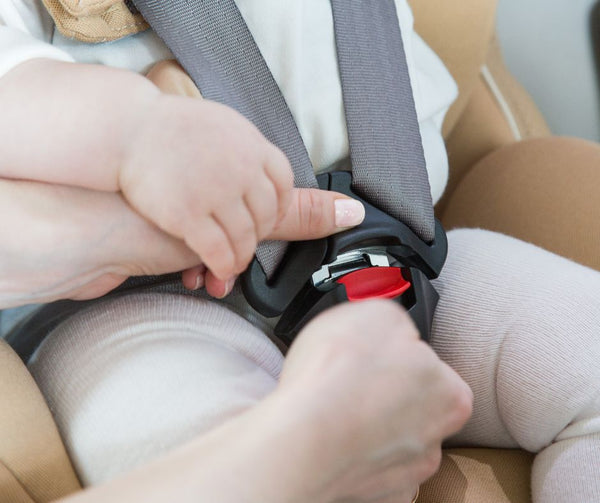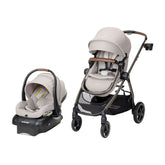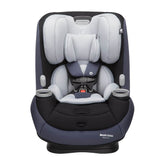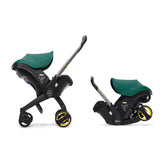How to Extend a Car Seat's Lifespan & When to Get a New One

Let’s face it: babies (and all the safety supplies they need) can be expensive. At ANB Baby, we understand how important it is for you to get the most from your baby gear investments while still prioritizing your little ones’ well-being. This is especially true when it comes to car seats. For many families, a car seat is one of the most expensive purchases they’ll make for their child. Therefore, it makes sense to care to give it any special care or maintenance it may need to extend its lifespan. From cleaning routines to preventative maintenance, let's explore how you can make your car seat last as long as safely possible.
Cleaning Techniques for a Spotless Car Seat
Your child's car seat is not just a means of transportation; it's a haven of safety and comfort. To keep it in top-notch condition, cleanliness is key. Here’s how to help preserve both its functionality and appearance.
1. Regular wipe-downs
Keeping your car seat clean starts with regular wipe-downs. Use a mild detergent and warm water to clean the surfaces. You can even use a vacuum to get into the crevices where crumbs and spills accumulate.
2. Stain removal hacks
Accidents happen, but they don't have to leave a permanent mark. Research gentle stain removal hacks like using baking soda for odors or a mixture of vinegar and water for tougher stains. These simple remedies can go a long way in preserving the appearance of your car seat.
3. Machine-washable covers
Opt for car seats with machine-washable covers. This makes the cleaning process more convenient and ensures your seat always looks fresh. Remember to follow the manufacturer's guidelines for washing to avoid damaging the fabric.

Preserving Car Seat Straps and Buckles
When cleaning the car seat, it’s especially important to preserve the strength and reliability of the car seat straps and buckles, essential parts for securing your little one during every journey. Let's look at how to care for straps and buckles while still ensuring these vital parts perform optimally when it matters most.
1. Avoid harsh chemicals
Avoid harsh chemicals that can weaken the material. Stick to mild soap and water solutions. Never submerge these components in water or remove them from the car seat, as it can compromise their integrity.
2. Check for tangles
Straps can get tangled over time, affecting their effectiveness. Regularly check for any twists or knots, and untangle them gently. Ensuring the straps are flat and untwisted maintains their strength during sudden stops or impacts.
3. Protect from sun damage
Prolonged exposure to sunlight can weaken straps and make them less reliable. Park your car in the shade whenever possible, or use sunshades to protect your car seat from UV rays.

Performing Regular Inspections for Wear and Tear
Just as your car undergoes routine check-ups to maintain peak performance, so too should your child's car seat. The wear and tear on this vital safety apparatus can impact its ability to safeguard your little one during every ride. Proactive maintenance can help ensure that your child's safety is never compromised.
1. Frequent check-ups
Treat your car seat like you would your car. Regularly inspect it for signs of wear and tear. Check for loose screws, damaged padding, or any other issues that might compromise safety.
2. Replace worn parts
If you notice any parts showing signs of deterioration, don't hesitate to replace them. ANB Baby and most manufacturers offer replacement parts, ensuring your car seat remains in top-notch condition.

Understanding Car Seat Expiration
Many parents are surprised to learn that, just like coupons or dairy products, car seats have an expiration date. When and why do car seats expire, and how long are they good for? Let’s break down all the details, including how to find your car seat’s expiration date and what to do once it expires.
Why do car seats expire?
It might sound strange that car seats have an expiration date but think of them like a set of tires. After so many trips, the tires’ materials break down and don’t support your vehicle the way they should. The same happens with a car seat, which weakens over time with constant use and exposure to heat and cold. The purpose of a car seat is to keep your child safe when traveling. After so many uses, the materials wear down and aren’t as strong as they once were. Therefore, car seats have a specific lifespan and will eventually expire. Expiration dates also help ensure that the seats in circulation incorporate the latest improvements in car seat safety.
How long do car seats last?
Due to differing materials and manufacturing methods, there isn’t a universal standard or federal regulation for how long car seats last. Every car seat brand is different, but many manufacturers set an expiration date of somewhere between six to ten years.
Where is the expiration date on a car seat?
To find out how much longer your car seat is good for, check the bottom of the seat or inspect the plastic frame for a stamped expiration date. If you've purchased separate components, like a base and the seat itself, check each piece individually, as their expiration dates may differ.

Car seat expiration after an accident
While the expiration rule is clear-cut, there's a significant exception. If your car seat has been in a moderate or severe car crash, it's deemed immediately expired. The National Highway Traffic Safety Administration recommends replacing a seat if it was in a collision that involved injuries or required the vehicle to be towed, if the airbags were deployed, or if the seat or the door nearest the seat was damaged. Some manufacturers even recommend replacing the car seat after a minor accident that meets specific criteria. Before rushing to replace your car seat, consider these steps:
- Inspect the car seat for visible damage—if damaged, replace it.
- Examine the surrounding area for any damage to the car and the door nearest to the car seat.
- Reach out to the car manufacturer for advice. If advised, replace the car seat before your next journey.
New car seat vs. used car seat
While opting for a new car seat is ideal for expiration and recall concerns, budget constraints or trusted sources may lead you to consider a used one. Before deciding, consider the following:
- Trustworthiness of the seller: Ensure reliability when buying from a reputable source.
- Check for original parts: Confirm the presence of all original components, including labels, the instruction manual, and the expiration date.
- Recall check: Verify the car seat's registration with the National Highway Traffic Safety Administration (NHTSA) for any recalls.
- Manufacturer guidance: Consult the manufacturer for insights on the specific used car seat.
Do car seat bases expire?
When it comes to replacing your car seat, it's crucial to swap out the entire unit, including both the base and the seat. Despite the perception that the plastic base is sturdier, both components are susceptible to wear and tear or damage during a crash. If your base is older and hasn't been in an accident, you can replace them separately as each piece reaches its expiration. If in doubt, seek guidance from the manufacturer or a certified Child Passenger Safety (CPS) technician.
What to do with expired car seats
When faced with an expired car seat, the natural inclination may be to clear some space by tossing it in the trash—after all, who needs more baby gear clutter? However, experts strongly advise against this hasty solution. To ensure that no one unknowingly repurposes an expired car seat, it's crucial to take a few extra steps. Begin by dismantling the seat, and removing and discarding the foam, padding, and fabric. Cut the harnesses and straps, and separate any metal parts for recycling, along with the plastic components. On the car seat frame, prominently write "Do not use—expired" using a permanent marker. Finally, wrap the seat in a black plastic garbage bag and dispose of it following your local guidelines, contributing to both safety and environmental responsibility.

Knowing When to Upgrade Your Child's Car Seat
As our little ones grow, so do their needs in the realm of car seats. At some point, you’ll have to bid farewell to your current car seat. Understanding when to navigate towards a new car seat is key to a secure and comfortable ride for your growing passenger. Here are some key signs that it’s time for a new car seat, according to Consumer Reports:
- Outgrowing the infant seat: When your child surpasses the height limit of their rear-facing infant seat, it's time to consider upgrading to a convertible car seat that allows both rear and front-facing orientations.
- At 1 year old: If your child is one year old and still fits in a rear-facing infant seat, it's safer to switch to a rear-facing convertible seat. Recent crash simulations revealed potential head injury risks in rear-facing infant seats for older toddlers.
- Expiration date: Replace the seat when it reaches this limit to ensure key components remain intact and comply with contemporary safety standards.
- After a crash: Following a collision, replace the car seat if it was in a crash involving injuries, airbag deployment, towing, or damage to the seat or adjacent door.
- Visible damage: Regularly check for cracks, loose parts, and worn straps. If the car seat shows signs of damage, it may not provide optimal protection in a crash. Even if upgrading to the same type, a new, undamaged seat ensures better safety.
- Transition to the next stage: When your child outgrows their current car seat stage or is nearing that point, consider upgrading. Avoid rushing the transition for tempting savings, prioritizing safety over haste. Each stage transition should follow safety guidelines, favoring rear-facing and harnessed options over forward-facing seats and boosters.
The Takeaway on Car Seat Maintenance
Your child's safety is paramount, and a well-maintained car seat is the first line of defense. By incorporating these maintenance tips into your routine, you not only ensure a spotless and functional seat but also extend its lifespan. Budget-conscious parents understand the importance of making wise investments, and when it comes to car seats, a little care goes a long way. From regular cleanings to understanding expiration dates, these tips and tricks will help you navigate the journey of parenthood with confidence, knowing that your child is secure in their car seat.









